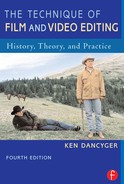32 |
Conclusion |
||
This book covers the theory and practice of editing from the beginning to the 1990s. We have far surpassed the skepticism that Rudolph Arnheim expressed when he said that technological changes such as sound could add nothing to the advancement of the silent film. Sound is now an artful addition to the repertoire of the film experience. This is also true of video.
Although they are different technologies, film and video have begun to merge. Movie screens are now smaller and television screens are larger than they once were, and the film audience is increasingly viewing films on a video format. Films that were once shot and edited on film are now shot on film and edited on video. Television shows that were once shot on video using three-camera studio techniques are now shot on video using single- camera filmic techniques. They are edited on tape, but have the look of a filmed show. The editing styles of films and taped television shows are becoming indistinguishable.
Much is different today from Alfred Hitchcock's time. Today's emphasis on technology—whether sound, image, or special effects—has placed a premium on sensation. On one level, the sensation of sound and image is what editing is about.
Because of its power, editing without an ethical dimension can only further the trend to use it to further sensation over more complex responses to film. This is the dangerous point at which we find ourselves today. In a sense, it places the artfulness of all that we have discovered—the power of film and television—in a spiritual vacuum.
When Eisenstein, Welles, and Buñuel created their works, they aimed to move the minds and emotions of their audiences. They used editing in a manipulative way, and yet their works had an ethical foundation. They deployed their creativity in a world of ethical choices. The music video—the apogee of sensation—encourages sensation with contextual reference but seems to have no ethical goals beyond the stimulus of the sound and image.
Eisenstein, Welles, and Buñuel did not live in a less difficult time than we do today. They managed to create works that speak to us vividly about ethics as well as aesthetics. The same is true for Truffaut and Antonioni and Kurosawa.
When I look at today's work, I see the height of technological achievement in such films as Terminator 2. I am entertained, but I am not moved to consider the ethics of violence or technology or relationships. The sensations of ear and eye are everything. Is that all there is? It seems to be. The post-modern world has arrived.
Here is the challenge. We have learned a great deal from and a great deal about the greatest art of this century. How do we want to use our knowledge?
